The ASRock X99 Extreme11 Review: Eighteen SATA Ports with Haswell-E
by Ian Cutress on March 11, 2015 8:00 AM EST- Posted in
- Motherboards
- Storage
- ASRock
- X99
- LGA2011-3
Much like the BIOS, the software for a consumer business unit motherboard often surpasses that provided by the professional market for functionality. Perhaps the only element missing that you would find on a server motherboard is one of delocalized control, but this is something I am putting to the motherboard manufacturers that focus on workstation level products. Nevertheless, features such as overclocking, fan controls and RAMDisk software comes as standard with the X99 Extreme11.
ASRock X99 Extreme11 Software
The software package from ASRock has gone through a slow evolution since Z77 into a single interface for all of ASRock’s functionality called A-Tuning. With the overclocking and gaming models the interface is slightly adjusted, but the green tint follows the majority of ASRock’s motherboard range. However the newest element to ASRock’s like is the APP Shop. This is essentially ASRock’s curated version of the Play Store/Microsoft Store, with only software ASRock feels is suited to their motherboard range.
Currently the software is fairly limited to Chrome, ASRock’s own software programs and a few Asian free-to-play titles. While offering this method to obtain software is interesting, it does open up a lot of questions. Will there be to-pay titles? What happens if one element of the store is filled with malware?
The APP Shop also offers a BIOS and Drivers section to update the system, but as of yet we have not had it working properly in our testing.
One suggestion has been that this software will only update the packages it downloads. There is another update tool in A-Tuning.
A-Tuning
The initial interface revolves around overclocking, giving the following three modes for automatic frequency adjustments:
Power Saving puts the CPU into a low power mode (1.2 GHz on the 5960X) and requires the system have full CPU load before slowly ramping up the speed over the next 6-10 seconds. This keeps power consumption down, but perhaps decreases the responsiveness of the system by not having that initial high single core frequency. Standard mode is the default setting, and Performance mode puts the CPU into high frequency mode for any loading. Performance Mode also opens up the Advanced menu:
Here we have a list of Optimized CPU OC Settings similar to the BIOS and an auto tuning section. There is no list of auto tuning options similar to ASUS, for adjusting the stress tests or the optimum CPU temperature, although I would imagine that all the manufacturers might move in that direction at some point in the future.
The tools menu has a lot of space for ASRock to add in future features, but currently houses the ones they do have. XFast RAM allows the system to partition some of the RAM into a RAMDisk while also providing some RAMCache options:
XFast LAN is a customized interface for cFos, allowing users to prioritize certain applications over others:
Personally I find this interface extremely cumbersome, especially if there are a lot of applications to deal with. ASRock could design something with less white space and a more efficient amalgamation of the A-Tuning visual dimensions to make the process a lot easier. There is access to cFos directly with the Advance Setting button:
The software works with all the network ports on board.
Fast Boot enables options relating to UEFI quick booting by disabling certain options until the OS is loaded:
The Online Management Guard (OMG [!]) has been around for several generations of ASRock motherboards now, and offers the user the ability to disable the networking ports during certain times of the day.
ASRock’s Fan software in the software now mirrors that in the BIOS, giving a better sense for the user in what to adjust:
The FAN Test will detect the RPM for a given fan power, although the graph on the left is misnamed – what ASRock calls ‘FAN Speed (%)’ is actually deceptive because it means ‘Fan Power’ and the user has to do the mathematics in their head to adjust based on the table in the middle. If ASRock was on the ball, they would do the conversion in software and adjust the graph to read ‘Fan Speed (RPM)’ and adjust the axis appropriately from lowest Fan Speed to highest Fan Speed. Note that the high fan speeds above are actually the speeds from my liquid cooling pump.
The Dehumidifier tool in the software is identical to that in the BIOS, allowing the system to enable the fans after the system has been shut off in order to equalize the air temperature inside and outside the case. This has benefits in humid environments where the moisture in the air may condense inside the case during a cool night after a hot day.
The USB Key tool allows users to assign a particular USB drive with login data for particular Windows users. This means that users need not remember a particular long password to log in, and only specified users are allowed to log in. Though lose the USB drive and lose the ability to log in.
One of the newer tools in ASRock’s list is the DISK Health Report. This gives the critical information on the drives attached to the system, allowing SSD users to see the life of their drive. This drive is very new for my motherboard test beds, as represented by only a few hours in actual operation.
The next tab along the top is the OC Tweaker, featuring the more critical options from the BIOS for manual overclocking along with some options to save overclock profiles. The way this is shown in ASRock’s software is quite user-unfriendly, and I would suggest that the next iteration of the software gives an experienced user an easier way to adjust frequencies and voltages without dealing with sliding bars and scrolling.
The System Info tab gives the hardware monitor page by default, giving information about the frequencies, fan speeds and voltages in the system. Most other manufacturers have a way of recording this data, or seeing it plotted on a graph while running a stress test, but ASRock is behind on this front at this time.
The Hardware Monitor section of System Info is identical to that in the BIOS, showing where hardware is installed with a mouse over giving basic details. This is handy for investigating which memory stick, USB or PCIe device is not being detected.
The Live Update tab is, by comparison to MSI, limited. Although I knew there were updates to the platform when I run this software, it failed to find the updated drivers. There has been a mini-update since the first implementation - it also does now mentions how big each download is. If a user is on a limited or slow bandwidth package having to download 300MB of audio or graphics drivers can be detrimental, so having this information is vital.




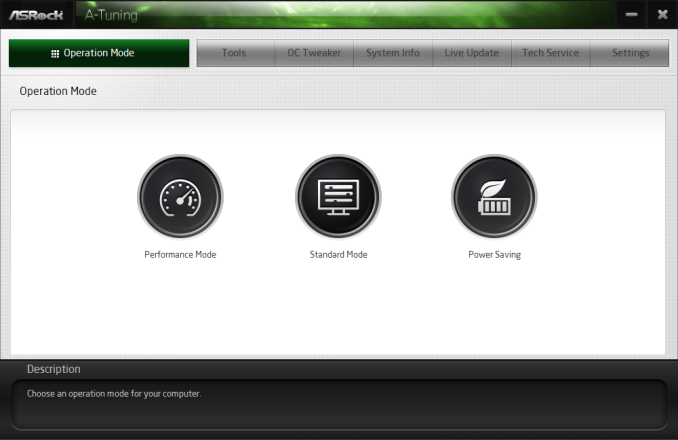
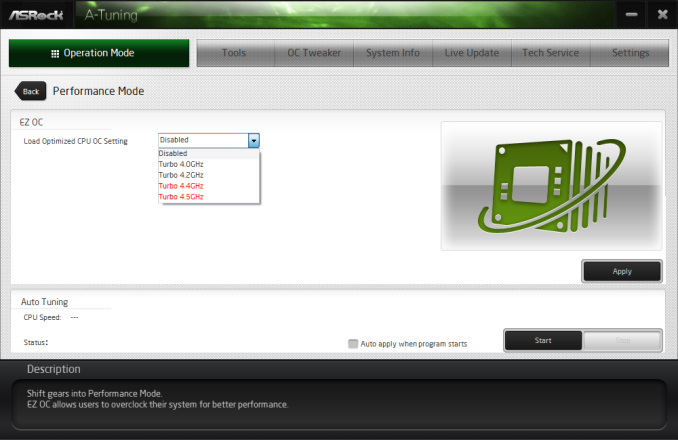
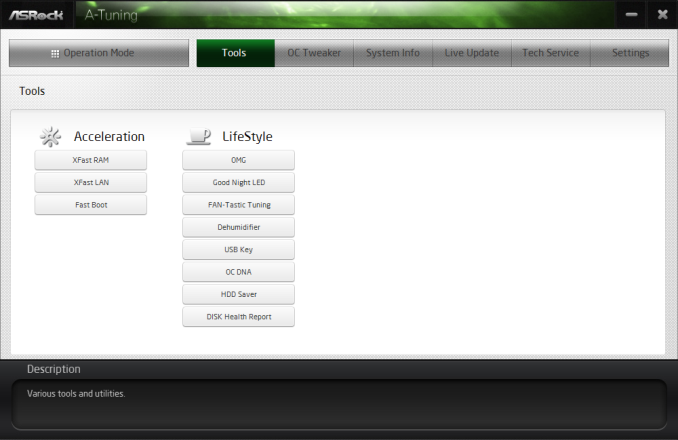
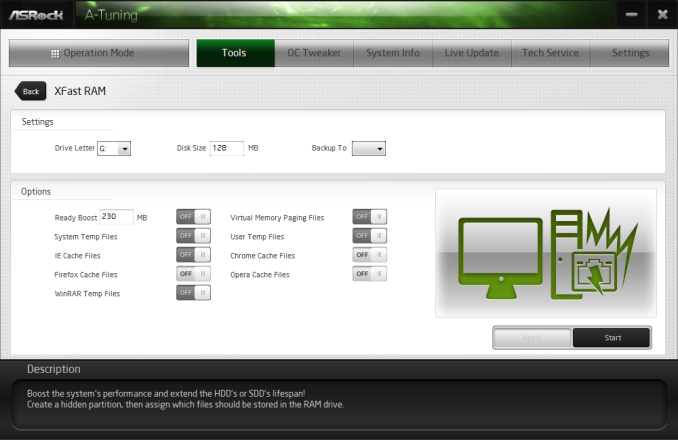
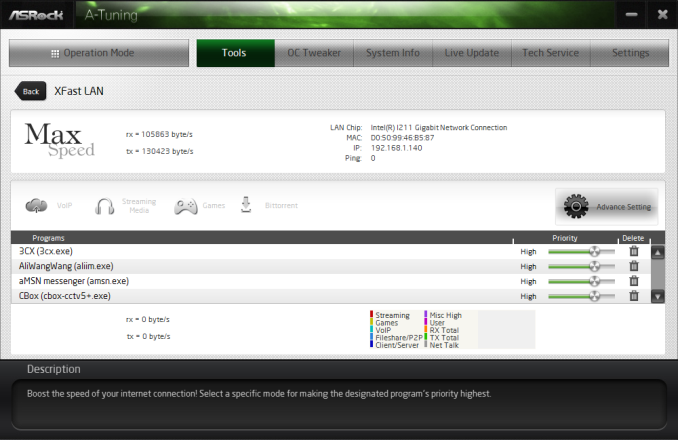
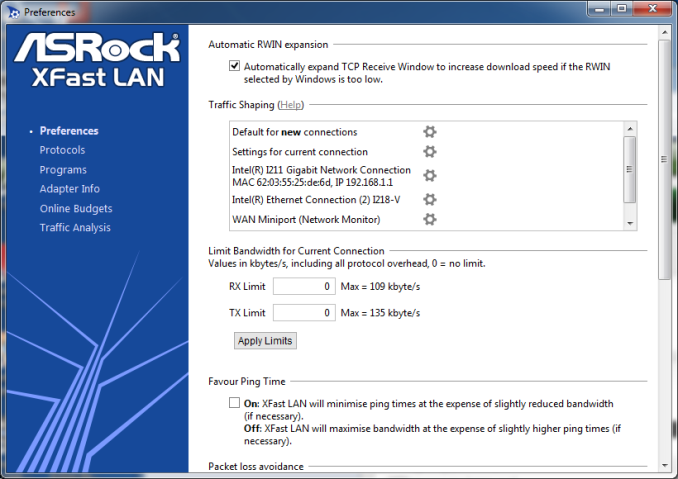
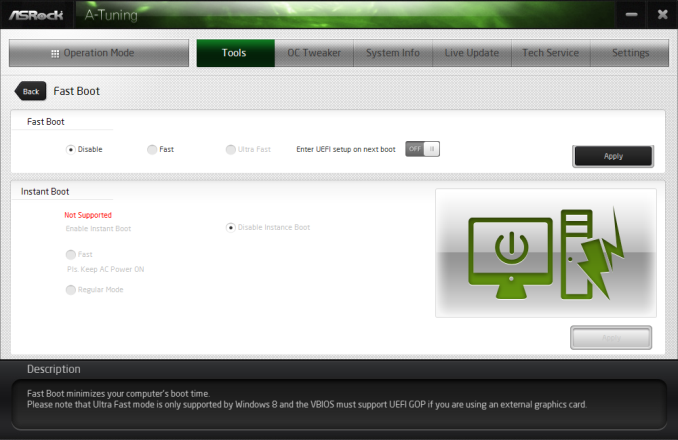
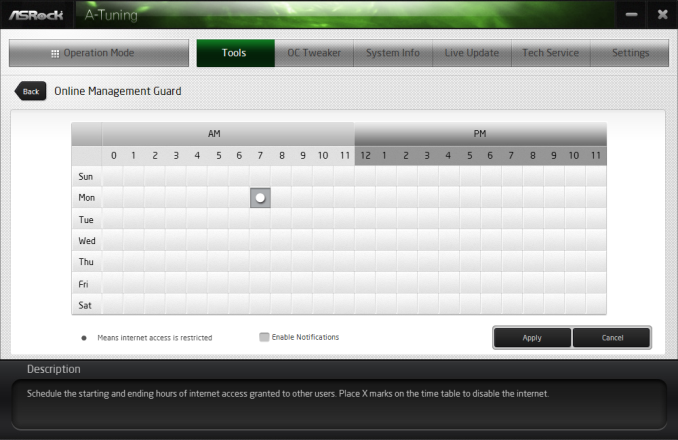
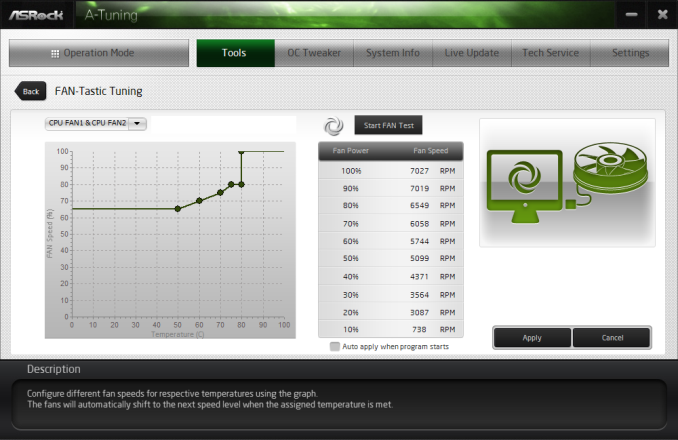
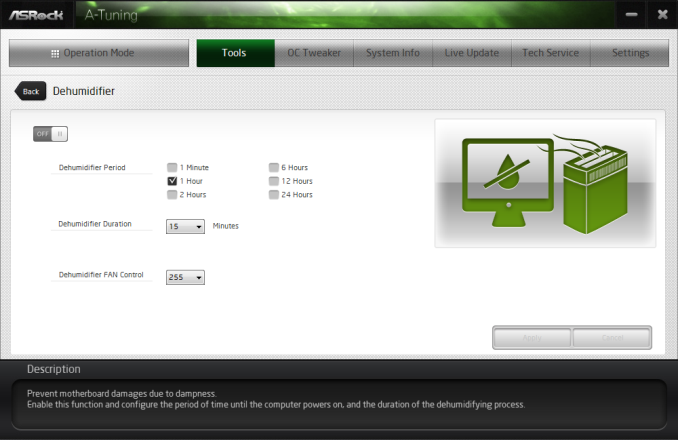
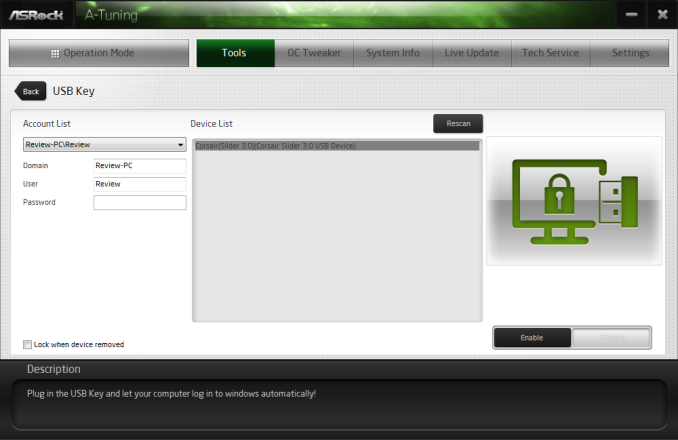

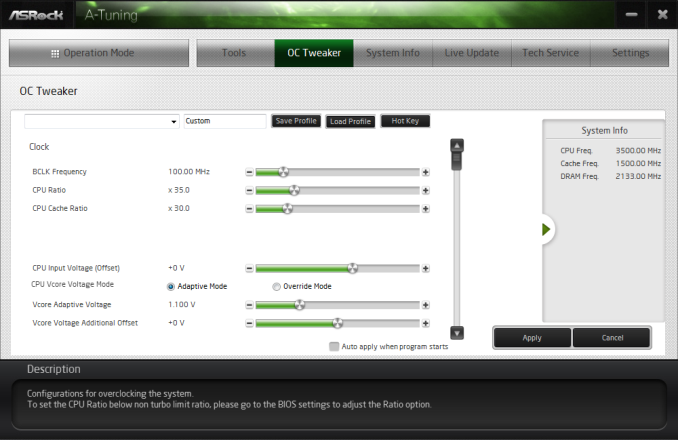

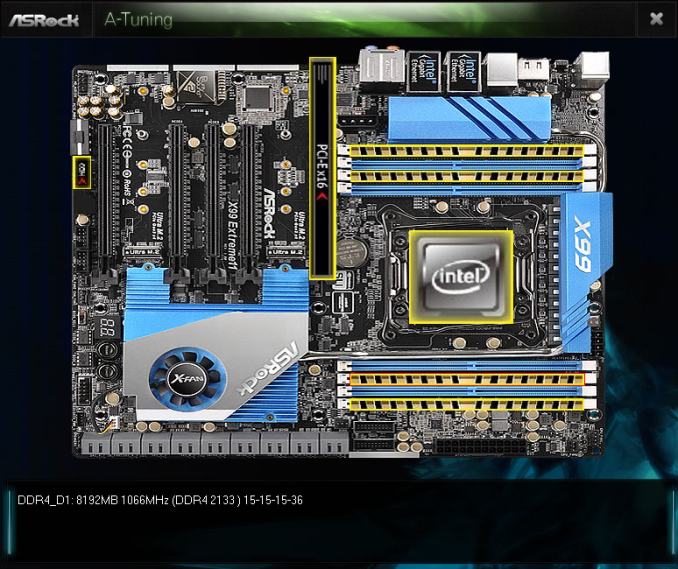
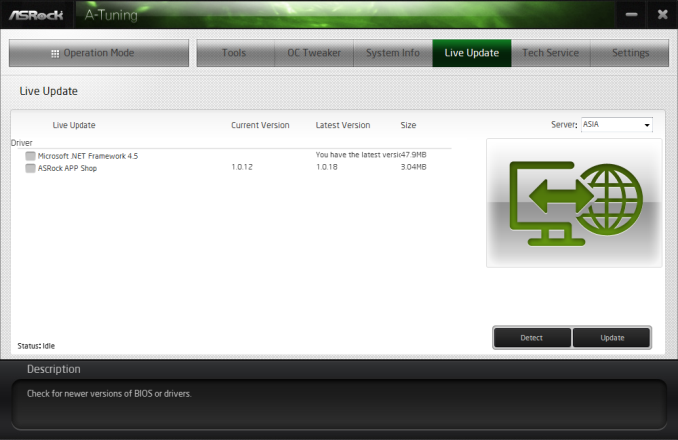














58 Comments
View All Comments
lordken - Friday, April 3, 2015 - link
Rather you should apology for being lazy. abufrejoval did run some math for you, so its pretty clear that all 18x ports wont deliver full bandwidth. If you need to run 18x SSD at full speed then you probably need server board or something.If you want to troll go elsewhere.
petar_b - Friday, January 29, 2016 - link
abufrejoval is not theoretical - 1 SSD on PCH can do 400Mb/s, but 4 SSDs simultaneously can give less 100MB/s transfer each. Now move that on SAS controller and each SSD gives 400MB/s.Once you start using SSDs on SAS - you will never go back to PCH.
I posted article a year ago on the web showing differences I have measured with crystal benchmark - values are shocking... measurements were based on ASRock X79 Extreme11, same SAS controller just CPU and RAM bit slower.
wyewye - Friday, March 13, 2015 - link
Good point duploxxx.I haven't seen a professionally done review on this site for quite a while.
petar_b - Friday, January 29, 2016 - link
Motherboard has nothing to do with gaming, go for ROG if you wish gaming. Business use, rendering, 3D where storage needs to be fast and has to be SAS.We are using older generation of the board X79 with PLX and SAS controller. There are no words nor space here to explain you what performance increase we we hook up 8 SSDs (960G) on SAS instead of Intel...
It's perfect for virtualization on or cloud realization - example: 128GB RAM + 6T SSDs can accomodate more than 20 vmware images, each with 4GB ram, running perfectly on Xeon.
@dicobalt - keeping porn ? it's so sad ppl think no further than gaming and watching tv. go buy book and learn something... mathlab, 3d studio and earn money. actually get a tv and watch porn there.
3DoubleD - Wednesday, March 11, 2015 - link
Thanks for the review! This board is incredible. I run a storage server with a software raid (Unraid) and this board alone would handle all of my SATA port needs without the need for any PCIe SATA cards. The only issue is the price though. For $600 I could easily buy a $150 Z97 motherboard with 8 SATA ports and two PCIe 8x slots, buy two $150 PCIe 2.0 8x cards (each with 8 SATAIII ports), and I'd still have money left over (probably put it towards a better case!). Also, that's not counting the significant difference in CPU and DDR4 costs.Clearly this motherboard is meant for a use case beyond a simple storage server (so many PCIe 8x slots!), so I can't say they missed their intended mark. However, I really wish they could attempt something like this on the Z97 platform, more than 10 SATA ports but with no more than two (or three) PCIe 8x slots (even if some of them are 4x). Aim for a price below $250.
I can't pretend it would be a big seller, but I know I'd buy one!
WithoutWeakness - Thursday, March 12, 2015 - link
ASRock has the Z87 Extreme11 with 22 SATA III ports (6 from chipset, 16 from LSI controller) along with 4-way SLI support (x8,x8,x8,x8) and a pair of Thunderbolt 2 ports. I'm not sure how feasible it is to plan on using all of those with only 16 PCIe 3.0 lanes from the socket 1150 CPU but it sounds like everything you're asking for. Unfortunately it came in over $500, double your asking price.I think you'll be hard pressed to get what you're looking for at that $250 mark, especially on a Z97 board. Socket 1150 CPUs only have 16 lanes and every manufacturer who is willing to put an 8+ port RAID controller on board will also want a PLX PCIe bridge chip to avoid choking other PCIe devices (GPU's, M.2 drives, etc). The RAID chip alone would bring a $100 motherboard into the $200+ range and adding the PLX chip would likely bring it to $250+. At that point every manufacturer is going to look at a board with 14+ SATA ports, a PLX chip, and a Z97 chipset and say "lets sell it to gamers" and slap on some monster VRM setup, additional USB 3.0 ports, 4 PCIe 16x lanes, bake in some margin, and sell it for $400+.
3DoubleD - Friday, March 13, 2015 - link
Makes sense. Thanks for the suggestion, I'll look into it. Not sure why I've never come across this board, doesn't seem like it is sold at any of the common outlets I shop at (Newegg.ca, ect.). Still, going the add-in SATA cards seems to be the more economical way.wintermute000 - Sunday, March 15, 2015 - link
You wouldn't have ECC with Z97.Maybe unraid is better than ZFS/BTRFS but I still wouldn't roll with that much storage on a software solution (vs HW RAID) without ECC.
Vorl - Wednesday, March 11, 2015 - link
This is such a strange board. with 18 SATA connections, the first thing everyone will think is "storage server". if all 18 ports were handled with the same high end RAID controller then the $600 price tag would make sense. As it is, this system is just a confused jumble of parts slapped together.Who needs 4 PCIE x16 slots on a storage server? That is an expense for no reason.
Who needs 18 SATA connections that are all mixed around on different controllers that can't all be hardware raided together? Sure, you can run software raid, but for $600 you can buy a nice raid card, and sas to sata breakout cards and cables, and still be ahead due to full hardware performance with cache.
Also, for a server, why would they not have the IGP port? I may be missing something, but I thought they CPU has integrated graphics.
Just not an awesome setup from what I can tell.
So.. why bother having all those sata ports if they aren't all tied to RAID?
They add an LSI controller, and that isn't even what handles RAID on the system.
1nf1d3l - Wednesday, March 11, 2015 - link
LGA2011 processors do not have integrated graphics.